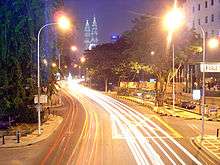Ampang, Kuala Lumpur
| Ampang | |
|---|---|
|
A view from Ampang Road, with the Petronas Twin Towers on the left. | |
 Ampang Location within Malaysia | |
| Coordinates: 3°9′38″N 101°44′9″E / 3.16056°N 101.73583°E | |
| Country | Malaysia |
| State | Federal Territory of Kuala Lumpur |
| Constituency | Titiwangsa |
| Government | |
| • Local Authority | Dewan Bandaraya Kuala Lumpur |
| • Mayor | Mhd Amin Nordin Abdul Aziz |
| Time zone | MST (UTC+8) |
| Postcode | 68xxx |
| Dialling code | +60 3 |
| Police | Dang Wangi |
| Fire | Pudu |
Ampang is a historic town and district of Kuala Lumpur (KL) in the Titiwangsa constituency, partly located in the state of Selangor, Malaysia and was historically a tin mining town. Its area in Kuala Lumpur can be identified as being along the Ampang Road and Ampang Hilir.
History
Ampang's history is closely related to the history of Kuala Lumpur. In 1857, Raja Abdullah, a representative of the Selangor Sultanate, opened up the Klang Valley for tin mining.[1] 87 Chinese miners from Lukut went up the river Klang and landed at Kuala Lumpur, then walked for a few miles through a jungle path to Ampang and began prospecting in the Ampang area. However, within a month 69 of the 87 miners had died due to the malarial conditions of the area, and Raja Abdullah sent another 150 men to continue the work. Eventually the death rate dropped, and the first tin was exported in 1859. The success of tin mining at Ampang led to the development of Kuala Lumpur.[2] The name "Ampang" means "dam" in Malay and the place was named in reference to the miners' dams.[3]
Kuala Lumpur of which Ampang is part of was made capital of Selangor in 1880 and the capital of the Federation of Malaysia in 1963.
Architecture

There are lots of pre-war buildings along Ampang Road. The Eng Choon Assembly Hall on Ampang Road for example was built in 1930. Its inner structure was rebuilt to support a taller building within. Eu Tong Sen, a leading businessman in the early 1900s, built a villa in 1935 on Ampang Road.[4] The same location was used by the British government as a military base. Over time it was renovated and reopened as the National Art Gallery on 27 August 1958[5][6] and much later refurbished to become the Malaysia Tourism Centre (MaTiC).[7] Eu Tong Sen also owned a tin mine in Ampang which was the first to install an electricity generator in 1914.[8]
Founded in March 1896, the Selangor Turf Club's former horse racing venue was one of the most popular landmarks in Ampang until it was demolished on 1 March 1997 to make way for the Petronas Twin Towers project.[9][10]
Many pre-war and British colonial buildings were extensively renovated and modernised. Lack of clear guidelines for architectural conservation in the city means unregulated alterations of pre-war buildings are common.[11]
Geography

At 3°9′38″N 101°44′9″E / 3.16056°N 101.73583°ECoordinates: 3°9′38″N 101°44′9″E / 3.16056°N 101.73583°E, Ampang is situated to the east of the Kuala Lumpur city centre. Ampang has several large lakes due to its tin mining history.
Ampang Road (from Leboh Ampang in KL to the main road in front of Ampang LRT station) is the main road to Ampang Jaya and is easily accessible from Jalan Tun Razak or Jalan Ulu Kelang from the Hulu Kelang or Setapak direction. It is also accessible from Cheras through Jalan Shamelin, from Jalan Tun Razak through Jalan Kampung Pandan via Taman Cempaka, from Kampung Pandan through Jalan Kampung Pandan Dalam via Taman Nirwana, from the Kuala Lumpur Middle Ring Road 2 via Pandan Indah & Taman Kencana and from Hulu Langat town through the mountain pass. Wangsa Maju, Setapak, central Kuala Lumpur, Ampang Park and Salak South surround Ampang.
Embassies
Many embassies are located in the Ampang area, and still remain there despite the Malaysian government's relocation to the new administrative centre in Putrajaya. The embassies are located along Ampang Road, including those of the United Kingdom, France, China, Russian Federation, Indonesia, Ireland and Thailand. The Singapore High Commission and the U.S. embassy are also located near Ampang at the corner of Jalan Tun Razak and Jalan U Thant.
Art and culture
The National Art Gallery is in the direction of Kuala Lumpur's downtown area. It displays creative and contemporary art pieces and sculptures. Located just next to the National Art Gallery is the Istana Budaya, Malaysia's cultural centre where performances and theaters are held.
See also
- Ampang, Selangor, Selangor's segment of greater Ampang.
Sister cities
References
| Wikivoyage has a travel guide for Ampang - Kuala Lumpur. |
- ↑ Ho Kay Tat (27 October 1986), "Not enough visitors to the Gedung", New Straits Times Malaysia, p. 5
- ↑ J.M. Gullick (1955). "Kuala Lumpur 1880-1895" (PDF). Journal of the Malayan Branch of the Royal Asiatic Society. 24 (4): 10–11.
- ↑ J.M. Gullick (1983). The Story of Kuala Lumpur, 1857-1939. Eastern Universities Press (M). pp. 2–4. ISBN 978-9679080285.
- ↑ John Kam (31 July 1980), "What a magnificent heritage", New Straits Times Malaysia, p. 16
- ↑ Lam Seng Fatt (7 July 1985), "Art's big brother", Sundate, New Sunday Times Malaysia, p. 1
- ↑ "MaTiC History". Malaysia Tourism Centre. Retrieved 2009-06-23.
- ↑ Ooi Kok Chuen (11 December 1994), "Documenting the works of artists", New Sunday Times Malaysia, pp. 14–15
- ↑ D. Devika Bai (4 September 1995), "Where the Old World still beckons", New Straits Times, p. 1
- ↑ "Historic turf club reduced to rubble", New Straits Times Malaysia, pp. City Extra, 1 March 1993
- ↑ Annie Frieda Cruez (26 August 1992), "Celebrating with a tinge of sadness", New Straits Times Malaysia, p. 6
- ↑ "Historical bungalow reduced to rubble", New Straits Times Malaysia, p. 2, 24 May 1991
